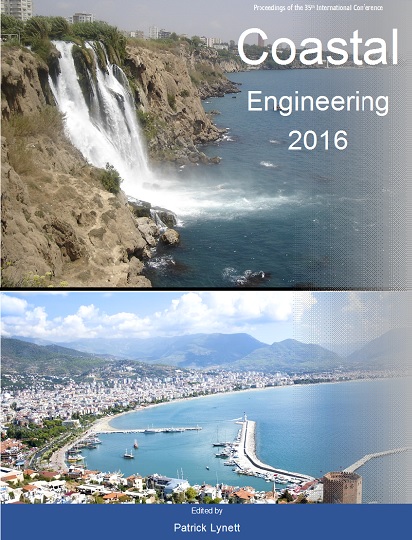Abstract
The objective of the present study was to study the morphodynamical development of ripples in a movable bed. The methodology is based on the coupling of fluid flow, sediment transport and morphodynamics. A well-resolved large-eddy simulation (LES) is employed for the simulation of the three-dimensional turbulent oscillatory flow and the corresponding bed and suspended sediment transport over a rippled bed. The evolution of the bed form is obtained by the numerical solution of the Exner equation based on the spanwise-mean flow and sediment transport conditions. The Immersed Boundary method is implemented for the imposition of fluid and sediment boundary conditions on the moving bed surface. Results are presented for ripple creation and propagation from a quasi-flat bed, as well as results of initially sinusoidal ripples adapting to water conditions, based on the mobility number, ψ. The numerical model demonstrates phenomena of ripple creation, propagation and migration, resulting in ripple lengths in agreement with those predicted by empirical equations. It was shown that under the same hydrodynamic forcing, the bed tends to reach the same equilibrium state, regardless of the initial bed form.References
Andersen, K.H., M.L. Chabanol, and M. van Hecke. 2001. Dynamical models for sand ripples beneath surface waves, Phys. Rev. E 63, 066308
Bagnold, R.A. 1946. Motion of waves in shallow water, interaction between waves and sand bottoms, Philos. Trans. R. Soc. London, A187, 1-15.
Balaras, E. 2004. Modeling complex boundaries using an external force field on fixed Cartesian grids in large-eddy simulations, Computers & Fluids, 33, 375-404.
Blondeaux, P. 1990. Sand ripples under sea waves Part 1. Ripple formation, J. Fluid Mech., 218, 1-17.
Blondeaux, P., and G. Vittori. 1991. Vorticity dynamics in an oscillatory flow over a rippled bed, J. Fluid Mech., 226, 257-289.
Clifton, H.E., and J.R. Dingler. 1984. Wave-formed structures and paleoenvironmental reconstruction, Mar. Geol., 60, 165-198.
Engelund, F., and J. Fredsøe. 1976. A sediment transport model for straight alluvial channels, Nordic Hydrology, 7, 293-306.
Ferziger, J.H., and M. Peric. 1999. Computational methods for fluid dynamics, 2nd Ed., Springer, New York.
Fredsøe, J., and R. Deigaard. 1992. Mechanics of coastal sediment transport, World Scientific, Singapore.
Giri, S., and Y. Shimizu. 2006. Numerical computation of sand dune migration with free surface flow Water Resour. Res. 42, W10422
Grigoriadis, D.G.E., A.A. Dimas, E. Balaras. 2012. Large-eddy simulation of wave turbulent boundary layer over rippled bed, Coastal Eng., 60, 174-189.
Hallermeier, R.J. 1981. Terminal settling velocity of commonly occurring sand grains, Sedimentology, 28, 859-865.
Marieu, V., P. Bonneton, D.L. Foster, and F. Ardhuin. 2008. Modeling of vortex ripple morphodynamics, J. Geophys. Res., 113, C09007.
Nielsen P. 1992. Coastal Bottom Boundary Layers and Sediment Transport, World Scientific, 324.
Niemann S.L., Fredsøe J., and Jacobsen N.G. 2011. Sand dunes in steady flow at low Froude numbers: Dune height evolution and flow resistance, J. Hydraul. Eng., 137 (1), 5-14.
Richards K.J., and Taylor P.A. 1981. A numerical model of flow over sand waves in water of finite depth, Geophys. J. R. Astron. Soc., 1, 103-128.
Scandura P., Vittori G., and Blondeaux P. 2000. Three-dimensional oscillatory flow over steep ripples, J. Fluid Mech., 412, 355-378.
Sleath J.F.A. 1984. Sea Bed Mechanics, Wiley Interscience Publication, New York, 335.
Smagorinsky, J. 1963. General circulation experiments with the primitive equations I. The basic experiment, Mon. Weather Rev., 91(3), 99-165.
van der Werf J.J., J.S. Doucette, T. O' Donoghue, and J.S Ribberink 2007. Detailed measurements of velocities and suspended sand concentrations over full-scale ripples in regular oscillatory flow, J. Geophys. Res., 112, F02012.
van Rijn, L.C., 1993. Principles of sediment transport in rivers, estuaries and coastal seas. Aqua Publications, Amsterdam, The Netherlands.

